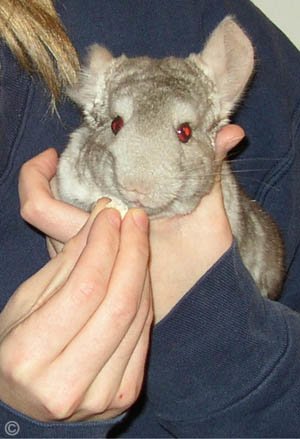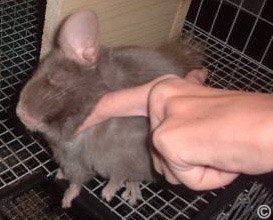 Taming a chinchilla needs to be done slowly if you are to build trust and bond together. The time it takes for a chinchilla to bond and trust you can vary as each chinchilla and its current situation is individual. In all cases the procedure for taming a chinchilla is the same and should never be rushed - a chinchilla will let you know when it is ready and if you push them too quickly (they have great memories), a week's progress can suffer a sever prolonged set back.
Taming a chinchilla needs to be done slowly if you are to build trust and bond together. The time it takes for a chinchilla to bond and trust you can vary as each chinchilla and its current situation is individual. In all cases the procedure for taming a chinchilla is the same and should never be rushed - a chinchilla will let you know when it is ready and if you push them too quickly (they have great memories), a week's progress can suffer a sever prolonged set back.
When entering a new home environment a chinchilla will be very stressed and nervous. They will need time to settle in, investigate their new home and become accustomed to the new noises, surroundings and smells they have just entered into before they start interacting.
Step 1 - On first arriving home with a chinchilla, place them into the cage you have prepared for them and offer one small raisin. Providing a raisin treat at this time shows your chinchilla that your intentions with them are all good and begins the bonding and trust process between the two of you. Do not over feed a chinchilla treats at this time (or at any time) even if it is really tempting - provide one raisin then leave the chinchilla in peace to explore and settle in to its new home.
WARNING - If a chinchilla is regularly fed treats through the bars of its cage it can mistakenly take a finger or nose as a treat and accidentally bite you - the same can be said if you have the smell of treats on your fingers so always wash your hands before and after handling a chinchilla.
Step 2 - Start taming a chinchilla by talking quietly to them and move around slowly as any sudden movements will cause them to retreat. Initially sit next to the chinchilla cage and talk quietly perhaps offering a small treat only when the chinchilla approaches the bars near you. Once the chinchilla is happy to take treats through the bars of the cage, they are ready to meet your hands again. Remember at this stage the only memory the chinchilla has of your hands is when you were examining them in the shop or rescue home, which would of caused them great stress at the time.
Step 3 - Open the door of the chinchilla cage and slowly place your hand inside. Don't pursue the chinchilla around its cage but let it come to you instead - once a chinchilla decides that you are interesting it will come up to you. If he becomes startled and runs away again or hides, don't move - a chinchilla will soon learn that you are not going to chase it and curiosity will bring him back to you again. You may find a chinchilla runs back and forth a number of times before he begins to feel confident and start sniffing your hands and fingers - a chinchilla may also give you a little nibble of curiosity but it wont hurt, its not a bite, it's just seeing what you are all about.
Step 4 - When the chinchilla is comfortable coming to your hands without hesitation, the next stage of taming a chinchilla is to let a chinchilla sit in your hands and remain there whilst eating a treat - organic oats are good at this stage as a chinchilla will take longer to eat the small pieces. Initially the chinchilla will want to jump off so keep ultra still and patient until the chinchilla is happy to remain in your hands. When a chinchilla is comfortable you can continue to move the treat further up your arm.
Step 5 - Once a chinchilla has become comfortable in your presence and comes to you as soon as you  open the door, you can start the second phase of taming your chinchilla by stroking him/her. Open the cage door and place your hand inside with your index finger ready, keeping your hand still at all times start by rubbing your finger gently over the top of the chinchilla's head (watch the whiskers because they are ticklish). At first a chinchilla will run away but if you stay still his curiosity will bring him back again. Keep repeat stroking the chinchilla with your index finger until the chinchilla starts to feel comfortable.
open the door, you can start the second phase of taming your chinchilla by stroking him/her. Open the cage door and place your hand inside with your index finger ready, keeping your hand still at all times start by rubbing your finger gently over the top of the chinchilla's head (watch the whiskers because they are ticklish). At first a chinchilla will run away but if you stay still his curiosity will bring him back again. Keep repeat stroking the chinchilla with your index finger until the chinchilla starts to feel comfortable.
As soon as the chinchilla is comfortable with climbing and staying on you, you can place your spare hand over their back and scoop the chinchilla up pulling him close to your chest.
Remember chinchillas will quickly try and jump out of your hands so the best way is to remain seated and try and stay as still as possible. You can offer one treat when you are holding your chinchilla so it gets used to good things coming from your hands and will begin to relax when you approach them to be picked up.
NOTE: - If a chinchilla gets upset at being stroked and doesn't come back to your hand just wait a few days before you attempt to touch and stoke him again - the whole idea of taming a chinchilla is to earn trust and not to break it. Some chinchillas just hate being stroked, are too ticklish or too wild and the moment you touch them they shake their head and rub their head/noses before running off. Some chinchillas just hate human hands - if hands are failing then another thing you can try is your nose!
Yes that's right....chinchillas generally don't like hands, which are mainly used for examination purposes (which they remember) but a nose is what chinchillas use on one another. You will find if you use your nose to rub around your chinchilla's ears, face and body they will find it less intimidating and you may be more successful.
Please remember that not all chinchillas will like to be picked up no matter how much patience you have so never force a chinchilla into doing something it doesn't want to do. Chinchillas have fantastic memories and forcing or pursuing them will make a chinchilla nervous of you, hide whenever you approach the cage and break any bonding you have already built up! All chinchillas will love to interact with you and climb on you whether they like to be stroked or not but they are only happy to do this on their own terms, not yours.
Taming Problem Chinchillas
Sometimes problems do occur as all chinchillas are individual and build trust at different rates. A chinchilla may also have a previous experience of living in an unsuitable environment or had bad owners. You will know if a chinchilla is scared of you as they never appear to sleep and as soon as they hear you approaching the cage, they are out looking at where you are. They may make vocal sounds or attempt to spray urine at you (if its a female). They may begin to chew their fur or tremble when being picked up.
These chinchillas will be more nervous and will take longer to tame but all they need is love, patience and above all perseverance. Some chinchillas take months even years before they fully trust you and any progress you make with taming a chinchilla is accumulative, which means any small advances is a stepping stone, which should be remembered.
If you have an ultra nervous chinchilla then follow the tips below but again remember with some chins you may never win their trust completely so don't be disappointed. Chinchillas are not that far removed from the wild (approximately 50 years) and their wild instincts are still very evident and may never be overcome.
-
If a chinchilla starts to become vocal, spray urine, hide away from you, then leave them in peace, close the cage door and come away from the cage.
-
Try not to look a chinchilla directly in the eye when picking them up. When holding them, look at them but close your eyes so you are not coming across as threatening to them.
-
Keep to a routine of when you open the cage door and always have a small treat to hand.
-
Offer a few organic oats from the palm of your hand (a chinchilla will have to remain closer to you for longer to eat all the small bits) but do not attempt to touch or hold the chinchilla.
-
Never let a problem chinchilla out of their cage until the taming and bonding process is completed. A nervous chin out on the loose will be even more nervous and a very hard chin to entice back into its cage.
-
Go back to the basics of taming a chinchilla and sit near but not next to the cage and talk quietly to the chinchilla. Look at them whilst you are talking but with your eyes closed, Begin to repeat words such as 'good boy' or 'good girl' and offer a small treat through the cage bars if the chin is near you.
-
Reassess the cage positioning and move the chinchilla cage to a quieter room if the current room is too noisy or active.
-
Keep the room the chinchilla lives in quiet during the daytime and when you start taming sessions have no other distractions around, like the TV on or people visiting/coming into the room.
-
Ultimately if a chinchilla never wants to be tamed or held, don't shout or punish them, just give them the freedom they need and readjust yourself around them - this is the commitment you made when you choose to buy a chinchilla and were aware that all chinchilla's are individuals and some do not like to be held.
TIP - If a chinchilla has never had a raisin before and doesn't take to it immediately, break it open slightly so the aroma escapes - you will then find your chinchilla happily eats the raisin and start begging for more - remember - do not give a chinchilla more than one raisin so use it wisely.
It maybe helpful to know, that chinchillas mellow to affection in older age, which should be remembered when you have a young feisty chinchilla or a chinchilla that may not like to be tamed at the moment.
A chinchilla can only have one treat per day so use it wisely!
Further Reading Relating To Taming a Chinchilla:
Catching a Chinchilla, Chinchilla Exercise, Holding a Chinchilla.


 Taming a chinchilla needs to be done slowly if you are to build trust and bond together. The time it takes for a chinchilla to bond and trust you can vary as each chinchilla and its current situation is individual. In all cases the procedure for taming a chinchilla is the same and should never be rushed - a chinchilla will let you know when it is ready and if you push them too quickly (they have great memories), a week's progress can suffer a sever prolonged set back.
Taming a chinchilla needs to be done slowly if you are to build trust and bond together. The time it takes for a chinchilla to bond and trust you can vary as each chinchilla and its current situation is individual. In all cases the procedure for taming a chinchilla is the same and should never be rushed - a chinchilla will let you know when it is ready and if you push them too quickly (they have great memories), a week's progress can suffer a sever prolonged set back. open the door, you can start the second phase of taming your chinchilla by stroking him/her. Open the cage door and place your hand inside with your index finger ready, keeping your hand still at all times start by rubbing your finger gently over the top of the chinchilla's head (watch the whiskers because they are ticklish). At first a chinchilla will run away but if you stay still his curiosity will bring him back again. Keep repeat stroking the chinchilla with your index finger until the chinchilla starts to feel comfortable.
open the door, you can start the second phase of taming your chinchilla by stroking him/her. Open the cage door and place your hand inside with your index finger ready, keeping your hand still at all times start by rubbing your finger gently over the top of the chinchilla's head (watch the whiskers because they are ticklish). At first a chinchilla will run away but if you stay still his curiosity will bring him back again. Keep repeat stroking the chinchilla with your index finger until the chinchilla starts to feel comfortable.